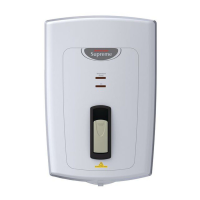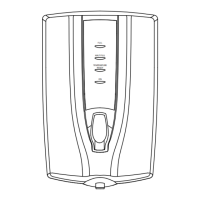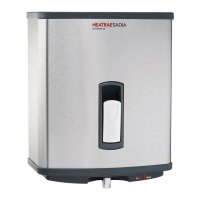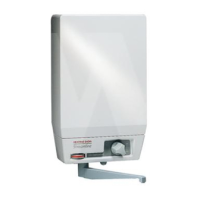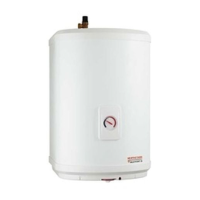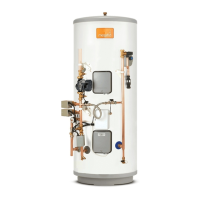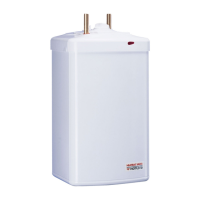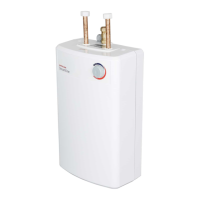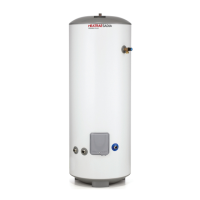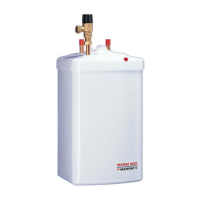Do you have a question about the Heatrae Sadia SUPREME and is the answer not in the manual?
Advises supplying the unit directly from a rising main or a compliant cistern, noting water quality impacts.
Discusses limescale buildup in hard water areas and suggests using a scale-reducing device.
Specifies adherence to Building Regulations and Water Fittings Regulations for installation.
Recommends mounting the unit for easy access and operator standing position, with specific tap height.
Emphasizes leaving sufficient space around the heater for maintenance and servicing.
Instructs to install the unit on a surface capable of withstanding near boiling temperatures and the unit's weight.
Recommends fitting a WRAS listed isolating valve for easier servicing.
Stresses the importance of flushing supply pipes before connection to prevent blockages.
Specifies using food-grade hose and meeting pressure requirements (20-1000 KPa) for potable water connection.
Details how the vent pipe should be laid with a continuous fall to a safe point, not directly to waste.
States the unit uses a 240v 13A plug and socket capable of carrying 3kW, and cord replacement.
Advises installing a residual current device (RCD) with a rated operating current not exceeding 30 mA.
Emphasizes that the appliance must be earthed for safety.
Confirms installation must conform to BS7671 (IEE Wiring Regulations).
Instructs to verify all electrical, water, and vent pipe connections are secure.
Details turning on the water supply then the electrical supply, ensuring the On/Off switch is on.
Describes the Wait/Ready light behavior during filling and heating, indicating temperature status.
Reminds to check for any leaks after commissioning.
Recommends regular de-scaling by a qualified engineer using approved chemicals to ensure reliability.
Mentions the unit's electronic scale conditioning feature and the need to remove any remaining deposits.
Links usage to scale build-up and suggests periodic inspection (6-12 months) for longevity.
Explains how to reset the solenoid if the unit has been starved of water for over 20 minutes.
Interprets service indicator light pulses, like 2 or 3 pulses for sensor de-scaling.
Details the meaning of a 4-pulse indicator (high level sensor issue/overfill) and troubleshooting steps.
Advises on methods for removing scale deposits from internal surfaces using gentle tapping or nylon pads.
Warns about using chemical de-scalants only as per manufacturer recommendations to avoid issues.
Stresses removing scale/moisture from level sensors before re-commissioning to prevent false signals and element failure.
Lists possible causes and remedies for the unit having no lights on the front panel.
Lists possible causes and remedies for the unit not dispensing boiling water.
Lists possible causes and remedies for the thermal cut-out tripping frequently.
Lists possible causes and remedies for overflows from the unit.
Lists the 3kW heating element part number for replacement.
Lists the solenoid valve part number for replacement.
Lists the level probes kit part number for replacement.
Details the procedure for dispensing water, emphasizing caution due to boiling temperature.
Explains how the tap handle stays open when fully pulled down and is spring-loaded otherwise.
Describes the meaning of the WAIT/READY and SERVICE indicator lights.
Lists the requirements for the guarantee to be valid, including correct installation and maintenance.
Specifies conditions not covered by the guarantee, such as frost damage or scale build-up.
Advises supplying the unit directly from a rising main or a compliant cistern, noting water quality impacts.
Discusses limescale buildup in hard water areas and suggests using a scale-reducing device.
Specifies adherence to Building Regulations and Water Fittings Regulations for installation.
Recommends mounting the unit for easy access and operator standing position, with specific tap height.
Emphasizes leaving sufficient space around the heater for maintenance and servicing.
Instructs to install the unit on a surface capable of withstanding near boiling temperatures and the unit's weight.
Recommends fitting a WRAS listed isolating valve for easier servicing.
Stresses the importance of flushing supply pipes before connection to prevent blockages.
Specifies using food-grade hose and meeting pressure requirements (20-1000 KPa) for potable water connection.
Details how the vent pipe should be laid with a continuous fall to a safe point, not directly to waste.
States the unit uses a 240v 13A plug and socket capable of carrying 3kW, and cord replacement.
Advises installing a residual current device (RCD) with a rated operating current not exceeding 30 mA.
Emphasizes that the appliance must be earthed for safety.
Confirms installation must conform to BS7671 (IEE Wiring Regulations).
Instructs to verify all electrical, water, and vent pipe connections are secure.
Details turning on the water supply then the electrical supply, ensuring the On/Off switch is on.
Describes the Wait/Ready light behavior during filling and heating, indicating temperature status.
Reminds to check for any leaks after commissioning.
Recommends regular de-scaling by a qualified engineer using approved chemicals to ensure reliability.
Mentions the unit's electronic scale conditioning feature and the need to remove any remaining deposits.
Links usage to scale build-up and suggests periodic inspection (6-12 months) for longevity.
Explains how to reset the solenoid if the unit has been starved of water for over 20 minutes.
Interprets service indicator light pulses, like 2 or 3 pulses for sensor de-scaling.
Details the meaning of a 4-pulse indicator (high level sensor issue/overfill) and troubleshooting steps.
Advises on methods for removing scale deposits from internal surfaces using gentle tapping or nylon pads.
Warns about using chemical de-scalants only as per manufacturer recommendations to avoid issues.
Stresses removing scale/moisture from level sensors before re-commissioning to prevent false signals and element failure.
Lists possible causes and remedies for the unit having no lights on the front panel.
Lists possible causes and remedies for the unit not dispensing boiling water.
Lists possible causes and remedies for the thermal cut-out tripping frequently.
Lists possible causes and remedies for overflows from the unit.
Lists the 3kW heating element part number for replacement.
Lists the solenoid valve part number for replacement.
Lists the level probes kit part number for replacement.
Details the procedure for dispensing water, emphasizing caution due to boiling temperature.
Explains how the tap handle stays open when fully pulled down and is spring-loaded otherwise.
Describes the meaning of the WAIT/READY and SERVICE indicator lights.
Lists the requirements for the guarantee to be valid, including correct installation and maintenance.
Specifies conditions not covered by the guarantee, such as frost damage or scale build-up.
| Type | Unvented |
|---|---|
| Installation | Wall Mounted |
| Temperature Control | Thermostatic |
| Material | Stainless Steel |
| Safety Features | Overheat Protection, Pressure Relief Valve |
| Water Feed | Mains Pressure |
| Maximum Operating Pressure | 10 bar |
| Insulation | Polyurethane Foam |
| Capacity | 7 Litres |
| Voltage | 230 V |
| Outer Casing Material | Plastic |
